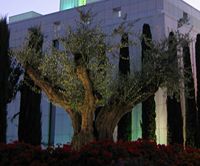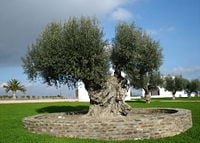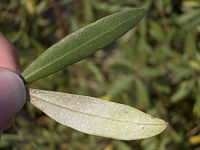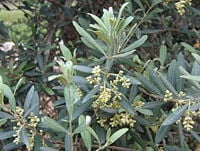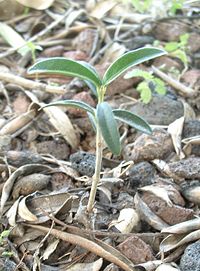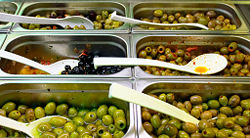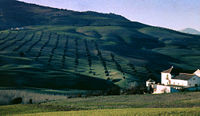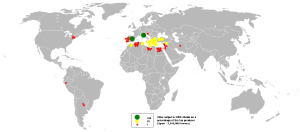Olive
| Olive | ||||||||||||||
|---|---|---|---|---|---|---|---|---|---|---|---|---|---|---|
 | ||||||||||||||
| Scientific classification | ||||||||||||||
| ||||||||||||||
| Olea europaea L. |
Olive is the common name for a evergreen tree or shrub, Olea europaea, in the flowering plant family Oleaceae, characterized by small size, squat shape, oblong opposite leaves, white flowers, and ovoid fruit. The name olive also refers to the edible fruit of this tree, a small drupe that is major agricultural importance in the Mediterranean region as the source of olive oil and as a food. It has been cultivated for thousands of years in the Mediterranean region, which remains the chief area of olive production, but the tree has been introduced to other subtropical and warm temperate climates. Olive is also the common name for the entire Oleaceae family, which includes the lilac, jasmine, forsythia, and ash.
Olive oil is commonly used in cooking, cosmetics, pharmaceuticals, and soaps and as a fuel for traditional oil lamps. Olive oil is considered a healthy oil because of its high content of monounsaturated fat (mainly oleic acid) and polyphenols. Other parts of the olive plant of value are the fruit itself, which is consumed as food; the fine yellow or light greenish-brown wood, which is hard and close-grained and valued by woodworkers; and the leaves, which are used in medicinal teas.
Description
Oleaceae, the olives and relatives, is a plant family containing 24 extant genera of woody plants, including shrubs, trees and vines. They are characterized by opposite leaves that may be simple or pinnately-compound. The calyx and corolla are four-lobed.
Many members of the family are economically significant. The olive proper, Olea europaea, is extremely important for its fruit and the oil extracted from it. The ashes, genus Fraxinus, are valued for their tough wood, and forsythia, lilacs, jasmines, privets, and fringetrees are all valued as ornamental plants.
The olive, Olea europaea. is native to coastal areas of the eastern Mediterranean region, from Syria and the maritime parts of Asia Minor to northern Iran at the south end of the Caspian Sea. It is short and squat, and rarely exceeds 8-15 meters in height.
The silvery green leaves are oblong in shape, measuring 4-10 centimeters (cm) long and 1-3 cm wide. The trunk is typically gnarled and twisted.
The small white flowers, with four-cleft calyx and corolla, two stamens and bifid stigma, are borne generally on the last year's wood, in racemes springing from the axils of the leaves.
The fruit is a small drupe 1-2.5 cm long, thinner-fleshed and smaller in wild plants than in orchard cultivars. Olives are harvested at the green stage or left to ripen to a rich purple color (black olive). Canned black olives may contain chemicals that turn them black artificially.
Some trees are quite ancient. Pliny the Elder told of a sacred Greek olive tree that was 1600 years old. Several trees in the Garden of Gethsemane (from the Hebrew words "gat shemanim" or oil press) in Jerusalem are claimed to date back to the time of Jesus (Lewington 1999). Some Italian olive trees are believed to date back to Roman times, although identifying progenitor trees in ancient sources is difficult.
However, the age of an olive tree in Crete, claimed to be over 2,000 years old, has been determined on the basis of tree ring analysis (Riley 2002). Another well-known olive tree on the island of Brijuni (Brioni), Istria in Croatia has been calculated to be about 1,600 years old. It still gives fruit (about 30 kg per year), which is made into top quality olive oil (BNP 2007).
Subspecies
There are at least five natural subspecies distributed over a wide range:
- Olea europaea subsp. europaea (Europe)
- Olea europaea subsp. cuspidata (Iran to China)
- Olea europaea subsp. guanchica (Canaries)
- Olea europaea subsp. maroccana (Morocco)
- Olea europaea subsp. laperrinei (Algeria, Sudan, Niger)
Cultivars
There are thousands of cultivars of the olive. In Italy alone, at least three hundred cultivars have been enumerated, but only a few are grown to a large extent. The main Italian cultivars are Leccino, Frantoio, and Carolea. None of these can be safely identified with ancient descriptions, though it is not unlikely that some of the narrow-leaved cultivars most esteemed may be descendants of the Licinian olive.
Since many cultivars are self sterile or nearly so, they are generally planted in pairs with a single primary cultivar and a secondary cultivar selected for its ability to fertilize the primary one; for example, Frantoio and Leccino. In recent times, efforts have been directed at producing hybrid cultivars with qualities such as resistance to disease, quick growth, and larger or more consistent crops.
Some particularly important cultivars of olive include:
- Frantoio and Leccino. These cultivars are the principal participants in Italian olive oils from Tuscany. Leccino has a mild sweet flavor while Frantoio is fruity with a stronger aftertaste. Due to their highly valued flavor, these cultivars have been migrated and are now grown in other countries.
- Arbequina is a small, brown olive grown in Catalonia, Spain. As well as being used as a table olive, its oil is highly valued.
- Empeltre is a medium sized, black olive grown in Spain. They are used both as a table olive and to produce a high quality olive oil.
- Kalamata is a large, black olive, named after the city of Kalamata, Greece and used as a table olive. These olives are of a smooth and meatlike taste.
- Koroneiki originates from the southern Peloponese, around Kalamata and Mani in Greece. This small olive, though difficult to cultivate, has a high oil yield and produces olive oil of exceptional quality.
- Pecholine or picholine originated in the south of France. It is green, medium size, and elongated. Their flavor is mild and nutty.
- Lucques originated in the south of France (Aude département). They are green, of a large size, and elongated. The stone has an arcuated shape. Their flavor is mild and nutty.
- Souri (Syrian) originated in Lebanon and is widespread in the Levant. It has a high oil yield and exceptionally aromatic flavor.
- Nabali is a Palestinian cultivar (Belaj et al. 2002). It also is known locally as Baladi, which along with Souri and Malissi are considered to produce among the highest quality olive oil in the world (Zatoun 2007).
- Barnea is a modern cultivar bred in Israel to be disease resistant and to produce a generous crop. It is used both for oil and for table olives. The oil has a strong flavor with a hint of green leaf. Barnea is widely grown in Israel and in the southern hemisphere, particularly in Australia and New Zealand.
- Maalot is another modern, disease-resistant, Eastern Mediterranean cultivar derived from the North African Chemlali cultivar. The olive is medium sized, round, has a fruity flavor and is used almost exclusively for oil production.
- Mission originated in the California Missions and is now grown throughout the state. They are black and generally used for table consumption.
History
The olive is one of the plants most cited in recorded literature. In Homer's Odyssey, Odysseus crawls beneath two shoots of olive that grow from a single stock. The Roman poet Horace mentions it in reference to his own diet, which he describes as very simple: "As for me, olives, endives, and smooth mallows provide sustenance" (Horace 30 B.C.E.). Lord Monboddo comments on the olive in 1779 as one of the foods preferred by the ancients and as one of the most perfect foods (Knight 1993).
It is not known exactly when the wild olive became a domesticated crop. A leaf from an olive tree is mentioned in chapter 8 of Genesis when Noah finds one in the dove's beak. In the Homeric world, as depicted in the Iliad, olive oil is known only as a luxury of the wealthy‚ÄĒan exotic product, prized chiefly for its value in grooming. Warriors would anoint themselves after bathing, and the body of Patroclus is described as being oiled in this way. But no mention of the cultivation of the plant is made, whereas a vineyard is mentioned in the description of Achilles' shield. But, although no reference to the cultivation of the olive occurs in the Iliad, the presence of the tree in the garden of Alcinous and other allusions show it to have been known when the Odyssey was written.
Among the earliest archaeological evidence for the domestication of olives comes from the Chalcolithic Period site of Teleilat Ghassul in what is today modern Jordan.
It is not known where the olive tree was first cultivated, but it traces very early to Asia Minor and spread to the Mediterranean. Tradition points to the limestone hills of Attica as the seat of its first cultivation on the Hellenic peninsula. The tree features in the myths of the founding of Athens: An olive is said to have sprung from the barren rock at the bidding of Athena, the city state's patron, when she fought with Poseidon. This suggests some relation to the first planting of the olive in Greece. There is also the remarkable story told by Herodotus of the Epidaurians, who, when their crops failed, were told by the Delphic Sibyl oracle to erect statues to Damia and Auxesia (symbols of fertility) carved from the wood of the true garden olive, then possessed only by the Athenians. They did so when granted their request for a tree by the Athenians (on the condition of making an annual sacrifice to Athena) and their lands became fertile again. The sacred tree of the goddess long stood on the Acropolis, and, though destroyed in the Persian invasion, sprouted again from the root. Some suckers of the original tree were said to have produced the later revered olive trees of the Academy.
By the time of the Athenian statesman Solon (c. 638 B.C.E.‚Äď558 B.C.E.), the olive had spread so much that he found it necessary to enact laws to regulate the cultivation of the tree in Attica. From here it gradually spread to all the Athenian allies and tributary states. Phoenician vessels may have taken olive cuttings to the Ionian coast, where it abounded in the time of Thales; the olives of the Sporades, Rhodes and Crete perhaps had a similar origin. Samos, if we may judge from the epithet of Aeschylus, must have had the plant long before the Persian Wars.
Olive oil has been more than mere food to the peoples of the Mediterranean: It has been medicinal, magical, an endless source of fascination and wonder, and the fountain of great wealth and power. The leafy branches of the olive tree, as a symbol of abundance, glory, and peace, were used to crown the victors of friendly games and bloody war, and the oil of its fruit has anointed the noblest of heads throughout history. As emblems of benediction and purification, they were also ritually offered to deities and powerful figures: Some were even found in Tutankhamen's tomb.
Cultivation, processing, and production
The olive has been cultivated since ancient times. Cultivation of the olive was (and remains) a key characteristic of Mediterranean mixed farming, and played a large part in the economic development of ancient Greece because of the suitability of olive oil as an export crop. For instance Attica, the region of Athens, was a grain importer and olive oil exporter from early historic times. The Athenian pottery industry was stimulated largely by the demand for containers in which to export olive oil.
Farmers in ancient times believed olive trees would not grow well if planted more than a short distance from the sea; Theophrastus gives 300 stadia (55.6 km) as the limit. Modern experience does not always confirm this, and, though showing a preference for the coast, it has long been grown further inland in some areas with suitable climates, particularly in the southwestern Mediterranean (Iberia, northwest Africa) where winters are milder.
Though the Mediterranean lands that were its ancient home remain the main source of the oil, the tree is now cultivated successfully in many regions of the world with Mediterranean climate, such as South Africa, Chile, Australia, New Zealand, Mediterranean Basin, Palestine, and California.
Soon after the discovery of the Americas, the olive tree was taken there by the Spanish settlers. In Chile, it flourishes as luxuriantly as in its native land, the trunk sometimes attaining a large girth, while oil of fair quality is yielded by the fruit. It was carried to Peru at a later date, but has not flourished as successfully there. It was introduced into Mexico by the Jesuit missionaries of the 17th century, and to upper California. Olive cultivation has also been attempted in the south-eastern states, especially in South Carolina, Florida, and Mississippi.
In the eastern hemisphere, the olive has been established in many inland districts that would have been anciently considered ill-adapted for it. It was known at a comparatively early period of history in Armenia and Persia, and many olive-groves now exist in Upper Egypt. The tree has been introduced into Chinese agriculture, and has become an important addition to Australia's farmers, and there are probably few coast districts there where the tree would not flourish. In Queensland, the olive has found a climate specially suitable, and in South Australia, near Adelaide. It has likewise been successfully introduced into some parts of South Africa and New Zealand.
The fruit, naturally bitter, typically is subjected to fermentation or cured with lye or brine to make it more palatable. Green olives and black olives are soaked in a solution of sodium hydroxide and washed thoroughly in water to remove oleuropein, a naturally bitter carbohydrate.
Green olives are allowed to ferment before being packed in a brine solution. American black ("California") olives are not fermented, which is why they taste milder than green olives.
Growth and propagation
Olive trees show a marked preference for calcareous soils, flourishing best on limestone slopes and crags, and coastal climate conditions. They tolerate drought well, thanks to their sturdy and extensive root system. A calcareous soil, however dry or poor, seems best adapted to its healthy development, though the tree will grow in any light soil, and even on clay if well drained. But, as remarked by Pliny, the plant is more liable to disease on rich soils, and the oil is inferior to the produce of the poorer and more rocky ground.
Olive trees can be exceptionally long-lived, up to several centuries, and can remain productive for as long, provided they are pruned correctly and regularly. The olive tree grows very slowly, but over many years the trunk can attain a considerable diameter. A. P. de Candolle recorded one exceeding 10 meters in girth. Even those of great age rarely exceed 15 meters in height, and are generally confined to much more limited dimensions by frequent pruning.
The olive is propagated in various ways, but cuttings or layers are generally preferred. The tree roots easily in favorable soil and throws up suckers from the stump when cut down. However, yields from trees grown from suckers or seeds are poor; it must be budded or grafted onto other specimens to do well (Lewington and Parker 1999). Branches of various thickness cut into lengths of about 1 meter and planted deeply in manured ground soon vegetate. Shorter pieces are sometimes laid horizontally in shallow trenches, where, covered with a few centimeters of soil, they rapidly throw up sucker-like shoots. In Greece, grafting the cultivated tree on the wild form is a common practice. In Italy, embryonic buds, which form small swellings on the stems, are carefully excised and planted beneath the surface, where they grow readily, their buds soon forming a vigorous shoot.
Occasionally, the larger boughs are marched and young trees thus soon obtained. The olive is also sometimes raised from seed, the oily pericarp being first softened by slight rotting, or soaking in hot water, or in an alkaline solution, to facilitate germination.
Where the olive is carefully cultivated, as in Languedoc and Provence, the trees are regularly pruned. The pruning preserves the flower-bearing shoots of the preceding year, while keeping the tree low enough to allow the easy gathering of the fruit. The spaces between the trees are regularly fertilized. The crop from old trees is sometimes enormous, but they seldom bear well two years in succession, and in many instances a large harvest can only be reckoned upon every sixth or seventh season.
Fruit harvest and processing
In southern Europe, the olive harvest is in the winter months, continuing for several weeks, but the time varies in each country, and also with the season and the kinds cultivated.
Most olives today are harvested by shaking the boughs or the whole tree. Another method involves standing on a ladder and "milking" the olives into a sack tied around the harvester's waist. Using olives found lying on the ground can result in poor quality oil. A device called the oli-net wraps around the trunk of the tree and opens to form an umbrella like catcher to catch fruit that is picked. Workers can then harvest the fruit without the weight of the load around their body. Another device, the oliviera, is an electronic tool that connects to a battery. The oliviera has large tongs that are spun around quickly, removing fruit from the tree. This method is used for olive oil variety olives. Table olive varieties are more difficult to harvest, as workers must take caution not to damage the fruit in any way. Picking baskets that hang around the worker's neck are used.
The amount of oil contained in the fruit differs greatly in the various cultivars; the pericarp is usually 60-70 percent oil. Typical yields are 1.5-2.2 kg of oil per tree per year.
Traditional fermentation
Olives freshly picked from the tree contain phenolic compounds and a unique glycoside, oleuropein, which makes the fruit unpalatable for immediate consumption. There are many ways of processing olives for table use. Traditional methods use the natural microflora on the fruit and procedures that select for those that bring about fermentation of the fruit. This fermentation leads to three important outcomes: the leaching out and breakdown of oleuropein and phenolic compounds; the creation of lactic acid, which is a natural preservative; and a complex of flavorsome fermentation products. The result is a product which will store with or without refrigeration.
During the process of fermentation, the olives can be tasted at any time as the bitter compounds are not poisonous, and oleuropein is a useful antioxidant in the human diet.
The olives are edible within two weeks to a month of fermentation, but can be left to cure for up to three months. Green olives will usually be firmer in texture after curing than ripe black olives. Olives can be flavored by soaking them in various marinades, or removing the pit and stuffing them. Herbs, spices, olive oil, feta, capsicum (pimento), chili, lemon zest, lemon juice, garlic cloves, wine, vinegar, juniper berries, and anchovies are popular flavorings. Sometimes the olives are lightly cracked with a hammer or a stone to trigger fermentation. This method of curing adds a slightly bitter taste.
Production
Olive is the most extensively cultivated fruit crop in the world (FAO 2005). Its cultivation areas has tripled in the past 44 years, passing from 2.6 to 8.5 million of hectares.
The first ten countries of production, as per FAO, are all located in the Mediterranean region, representing together 95% of the world production of olives.
| Rank | Country/Region | Production (in tons) |
Cultivated area (in hectares) |
Yield (q/Ha) |
|---|---|---|---|---|
| ‚ÄĒ | World | 17,317,089 | 8,597,064 | 20.1 |
| 1 | Spain | 6,160,100 | 2,400,000 | 25.7 |
| 2 | Italy | 3,149,830 | 1,140,685 | 27.6 |
| 3 | Greece | 2,400,000 | 765,000 | 31.4 |
| 4 | Turkey | 1,800,000 | 594,000 | 30.3 |
| 5 | Syria | 998,988 | 498,981 | 20.0 |
| 6 | Tunisia | 500,000 | 1,500,000 | 3.3 |
| 7 | Morocco | 470,000 | 550,000 | 8.5 |
| 8 | Egypt | 318,339 | 49,888 | 63.8 |
| 9 | Algeria | 300,000 | 178,000 | 16.9 |
| 10 | Portugal | 280,000 | 430,000 | 6.5 |
| 11 | Lebanon | 180,000 | 230,000 | 4.5 |
Pests and diseases
A fungus Cycloconium oleaginum can infect the trees for several successive seasons, causing great damage to plantations. A species of bacterium, Pseudomonas savastanoi pv. oleae (Janse 1982) induces tumor growth in the shoots, and certain lepidopterous caterpillars feed on the leaves and flowers. The main damage to the fruit is made by the olive-fly. In France and north-central Italy olives suffer occasionally from frost. Gales and long-continued rains during the gathering season also cause damage.
Another pest which spreads through olive trees is the black scale bug. Black scale is a small black beetle that resembles a small black spot. They attach themselves firmly to olive trees and reduce the quality of the fruit. The main predator of black scale is wasps.
Uses
The olive tree has been cultivated since ancient times as a source of olive oil, fine wood, and olives for consumption. The olive leaves also are used in medicinal teas. The yellow or light greenish-brown wood is often finely veined with a darker tint; being very hard and close-grained, it is valued by woodworkers. Besides food, olive oil has been used for religious rituals, medicines, as a fuel in oil lamps, soap-making, and skin care application.
The history of use of products of the olive tree has been extensive. Homer called olive oil "liquid gold." In ancient Greece, athletes ritually rubbed it all over their body. Drops of it seeped into the bones of dead saints and martyrs through holes in their tombs. A pleasing substitute for the butter and animal fats consumed by people to the north, the olive, among the southern nations of antiquity, became an emblem not only of peace but of national wealth and domestic plenty; the branches borne in the Panathenaea, the wild olive spray of the Olympic victor, the olive crown of the Roman conqueror at ovation, and those of the equites at their imperial review were symbols of peace that, in a barbarous age, could be secured by victory alone.
Among the Greeks, the oil was valued as an important article of diet, as well as for its external use. The Roman people employed it widely in food and cookery‚ÄĒthe wealthy as an indispensable adjunct to grooming; and in the luxurious days of the later empire it was said that long and pleasant life depended on two fluids: wine within and oil without. Pliny the Younger describes fifteen varieties of olive cultivated in his day, the Licinian being most esteemed, and the oil obtained from Venafrum in Campania, the finest known to ancient Roman connoisseurs. The produce of Istria and Baetica was then regarded as second only to that of the Italian peninsula.
Gourmets from the Roman empire to the present day have valued the unripe fruit, steeped in brine, as challenging to the palate. Pickled olives, retaining their characteristic flavor, have been found among the buried stores of Pompeii. The bitter juice deposited during pressing of the oil (called amurca), and the astringent leaves of the olive tree have many virtues attributed to them by ancient authors. The oil of the bitter wild olive was employed by Roman physicians in medicine, but does not appear ever to have had a culinary use.
Today, considerable research has been accumulated supporting the health benefits of consuming olives and olive oil. Evidence from epidemiological studies suggests that a higher proportion of monounsaturated fats in the diet is linked with a reduction in the risk of coronary heart disease (Keys et al. 1986). This is significant because olive oil is considerably rich in monounsaturated fats, most notably oleic acid. There is a large body of clinical data to show that consumption of olive oil can provide heart health benefits such as favorable effects on cholesterol regulation and LDL cholesterol oxidation, and that it exerts anti-inflammatory, antithrombotic, antihypertensive as well as vasodilatory effects both in animals and in humans (Covas 2007). Some clinical evidence suggests that it is olive oil's phenolic content, rather than its fatty acid profile, that is responsible for at least some of its cardioprotective benefits.
Olive as an invasive weed
Since its first domestication, Olea europaea has been spreading back to the wild from planted groves. Its original wild populations in southern Europe have been largely swamped by feral olive plants (Lumaret and Ouazzani 2001).
In some other parts of the world where it has been introduced, most notably South Australia, the olive has become a major woody weed that displaces native vegetation. Its seeds are spread by the introduced red fox and by many bird species including the European starling and the native emu into woodlands where they germinate and eventually form a dense canopy that prevents regeneration of native trees (Spennemann and Allen 2000).
Olive Branch as a Symbol of Peace
In the Judaeo-Christian tradition, a white dove carrying an olive branch is also a sign for peace. This comes from the Book of Genesis in the Hebrew Bible, in which a dove was released by Noah for a second time after the Great Flood in order to find land. The dove came back carrying an olive leaf in its beak, which informed Noah that God had taken mercy on humanity and caused the flood to recede:
And the dove came in to him in the evening; and, lo, in her mouth was an olive leaf pluckt off: so Noah knew that the waters were abated from off the earth. …
God then caused a rainbow to appear in the sky as a symbol of his covenant with mankind never to destroy the earth by water again. (Bible King James version. Genesis 8:11, 17)
This story has led to both the dove and the olive branch to become symbols of peace. The motif can also represent "hope for peace" or a peace offering from one person to another, as in the phrase "extend an olive branch."
ReferencesISBN links support NWE through referral fees
- Belaj, A., Z. Satovic, L. Rallo, and I. Trujillo. 2002. Genetic diversity and relationships in olive (Olea europaea L.) germplasm collections as determined by randomly amplified polymorphic DNA. TAG Theoretical and Applied Genetics. 105: 4. Retrieved November 7, 2007.
- Brijuni National Park (BNP). 2007. Old olive tree. Brijuni National Park. Retrieved November 7, 2007.
- Covas, M. I. 2007. Olive oil and the cardiovascular system. Pharmacol Res. 55(3): 175-186.
- Food and Agricultural Organization (FAO). 2005. Olive germplasm. FAO. Retrieved November 7, 2007.
- Horace. ca 30 B.C.E. Me pascunt olivae, me cichorea levesque malvae. Odes 1.31.15.
- Janse, J. D. 1982. Pseudomonas syringae subsp. savastanoi (ex Smith) subsp. nov., nom. rev., the bacterium causing excrescences on Oleaceae and Nerium oleander L. Int. J. Syst. Bacteriol 32: 166-169.
- Keys, A., A. Menotti, M. J. Karvonen, et al. 1986. The diet and 15-year death rate in the Seven Countries Study. Am J Epidemiol 124: 903‚Äď915.
- Knight, W. 1993. Lord Monboddo and Some of His Contemporaries. Bristol, UK: Thoemmes Press. ISBN 1855062070.
- Lewington, A., and E. Parker. 1999. Ancient Trees. London, UK: Collins & Brown Ltd. ISBN 1855857049.
- Lumaret, R., and N. Ouazzani. 2001. Ancient wild olives in Mediterranean forests. Nature 413: 700.
- Riley, F. R. 2002. Olive oil production on Bronze Age Crete: Nutritional properties, processing methods, and storage life of Minoan olive oil. Oxford Journal of Archaeology 21(1):63-75.
- Spennemann, D. H. R., and L. R. Allen. 2000. Feral olives (Olea europaea) as future woody weeds in Australia: A review. Australian Journal of Experimental Agriculture 40: 889-901.
- Zatoun. 2007. A brief study of olives and olive oil in Palestine. Zatoun. Retrieved November 7, 2007.
External links
All links retrieved November 17, 2022.
Credits
New World Encyclopedia writers and editors rewrote and completed the Wikipedia article in accordance with New World Encyclopedia standards. This article abides by terms of the Creative Commons CC-by-sa 3.0 License (CC-by-sa), which may be used and disseminated with proper attribution. Credit is due under the terms of this license that can reference both the New World Encyclopedia contributors and the selfless volunteer contributors of the Wikimedia Foundation. To cite this article click here for a list of acceptable citing formats.The history of earlier contributions by wikipedians is accessible to researchers here:
The history of this article since it was imported to New World Encyclopedia:
Note: Some restrictions may apply to use of individual images which are separately licensed.

